Gadfly
[Equine Management] A gadfly is a generic term for any species of fly that torments a horse. Various kinds of remedies can be employed to protect the horse or to reduce the fly population in their immediate area. If you notice your animal is suffering torment from flies, you should consider what else you can do for them.
Gag Snaffle Bit Bridle
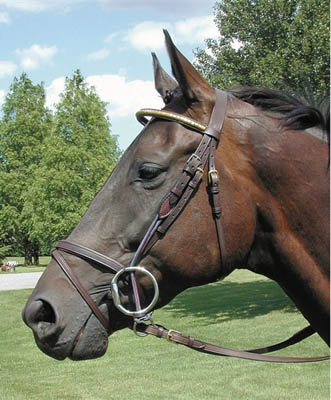
|
[Equine Equipage] A gag snaffle bit bridle uses a modified type of snaffle bit in combination with modifications to the bridle. There is a cheek piece passing through rings or slots on the bit that draws upwards and leverages the mouthpiece into the corners of the horse's mouth and excerpts pressure on the horse's pole. It is considered severe with considerable stopping power and should be used with a light hand. They are often used in sports such as polo or show jumping. They are not permitted in dressage. There is a wide variety of designs within the category of gag snaffles. They are generally used with two reins, but occasionally only one. If two reins are used one controls the snaffle alone and the other leverages the gag element.
Gait
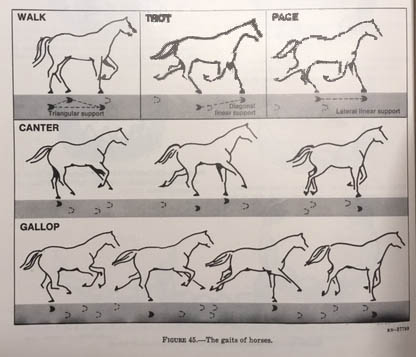
|
[Equine Locomotion] A horse's gait describes the particular manner of movement of a horse's legs during which it propels itself forward. Different gaits propel the horse at different speeds and the rider must learn the best way to ride the horse at a particular gait. The common natural gaits of all horses are: walk, trot, canter and gallop. The above diagram also shows a pace, an additional 5th gait that some horses have as a natural gait. During a pace the horse alternately moves the legs on each side of the body and must balance its weight on the set that are on the ground. With a trot its weight is also balanced on two legs but they are on diagonally opposite sides of the body, giving it better balance. I should mention if you have ridden several horses that you will notice that there are unique, individual characteristics to a given horse's gaits, similar to distinct patterns in a given person's walk. One horse might have a very springy trot and another a more difficult-to-sit-to canter on a given lead.
Gait Interference
[Veterinary Medicine] Gait interference (also called brushing) is when the hoof of the foreleg hits the hindleg during some phase of a horse’s stride often resulting in minor injuries. The simplest remedy is to use ankle boots. However, the cause may be worthy of a veterinary visit if the horse has more serious injuries, is lame or seems to be in pain.
Gaited Horse Breeds
[Equine Breeds] Gaited horse breeds are breeds that have additional gaits beyond walk, trot and canter. Among the better known breeds are American Saddlebreds Tennessee Walking Horses, Standardbreds and Paso Finos. The additions gait or gaits can be natural or trained.
Galiceño
[Horse Breed] Galiceños were introduced the the Americas by the Spanish and became established in Mexico. In more modern times some were imported into the United States. Galiceños are small, agile, extremely gentle in nature and easy to handle and train with gaits that are smooth. They make a good mount for a child.
Gall
[Veterinary Medicine] A sore area on a horse's body that results from pressure or chafing.
Gallop
[Gait of a Horse] A natural 4-beat gait that is faster than a canter. The horse has lengthened its stride and for a short interval during a gallop all feet are off of the ground. While the horse is cantering additional leg pressure will urge him into a gallop. Stationary objects fly by you, I tend to stand up a little in the stirrups out of the saddle and I often ask myself, "What in the world do I think I am doing up here?" The term hand gallop may imply that the rider actually has some control of the horse, which is a good thing but may not apply to myself. However in fairness, I can stop when I want to or so I think and generally do. Otherwise hang on, they cannot keep this up forever. Eons of evolution have created this superb running animal and here you see it in all its glory.
Galvayne's Groove
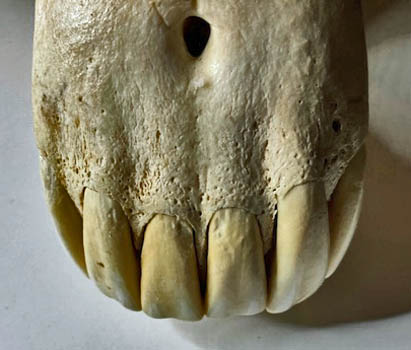
|
[Equine Dentition] Galvayne's groove is a groove in a horse's incisor that grows longer as the horse ages. It is a feature that contributes the the estimation of age by viewing the teeth.
Gaskin
[Equine Anatomy] The gaskin is the large muscle on the hind leg of a horse, located above the hock and below the stifle. It is equivalent to the calf of a human.
Gastric Ulcer Syndrome (EGUS or Stress Ulcer)
[Veterinary Medicine] Equine Gastric Ulcer Syndrome results from the natural acidity of the stomach acid overwhelming the natural protective barriers in the stomach. The ulcer is capable of perforating and resulting in death. This is tragic in that it is basically a treatable condition if recognized and that is the difficult part. Your horse cannot directly tell you. Often you need to treat situations in which the syndrome may develop and treat prophetically with omeprazole. Fasting, lack of fiber and being a Thoroughbred increases risk.
Gee
[Voice Commands] Gee is the voice command for a draft or plow horse to turn to the left. The word haw is used for a right turn.
Geld
[Veterinary Medicine] The act of castrating a male horse is to geld. This is generally done between 6 and 12 months of age.
Gelderlander
[Equine Breed] Gelderlander are a breed of horses native to the Netherlands. They are generally chestnuts and used for carriage driving. They was one of the foundation breeds of the Dutch Warmblood Horse and is now considered an endangered breed because of their small numbers
Gelding
[Equine Classification] A horse that has been gelded is a gelding. They are considered more manageable than a stallion.
German Martingale (Market Harborough)
[Equine Equipage] The German martingale is designed to restrict the ability of a horse to throw its head upwards. It is fairly similar to a running martingale, but the strap runs upwards and passing around the bit before snapping on one of a series of rings firmly secured to the reins. It is the most restrictive of the martingales and are for training and not for ordinary use. They are not permitted in competitions.
Gestation Period
[Equine Physiology] Horses have a 11-month gestation period, which is the time between conception and delivery. Prolonged gestation causes foals to have larger than normal frames and increased difficulty with delivery.
Get (also as Get on the Ground)
[Horse Breeding] The offspring sired by a given stallion.
Gidran (Gidrán)
[Horse Breed] Gidrans are a Hungarian breed of large, handsome riding horses. Their numbers are small and they are genetically at risk. All members of the breed are chestnut in color. In the closing days of World War Two there was wholesale destruction of horse herds in Hungary.
Gig
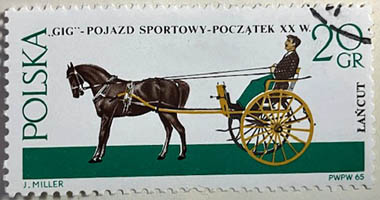
|
[Carriage Type] A gig is a popular, light, one-horse , two-wheeled type of carriage. One reason for its popularity is that it is easily to transport in the average truck.
Girth
[Horse Equipage] A piece fitted to the underside of a horse's body to hold the saddle in place. In English riding they are often leather or a synthetic material and buckle in place with the left side often having elastic bands for a flexible fit. Western tack often feature a girth (called a cinch), which is cinched up and tried off with a leather strap attached to the saddle. These straps are tried with a knot that is not unlike a gentleman's tie attached to brass rings on the ends of the cinch. Cinches are often made of a series of cloth cords that allow for air circulation. In any case, a rider should check the tightness of the girth or cinch, which should neither be too tight or too loose. A loose girth allows the saddle to slide from side to side and even end up under a horse. When that happens that leaves the rider feeling rather ridiculous. Believe it or not I have seen this happen to riders twice. They fall off before the saddle gets all the way around, of course. An overly tight saddle can stress and rub a horse. A good fit allows three figures to be slid between the horse and the girth.
Girth Galls
[Veterinary Medicine] Girth galls are sores resulting from the friction of the girth rubbing on the horses skin near the foreleg. Many factors contribute including a poorly positioned, too tight, inadequately cleaned or worn girth. They are best prevented by paying attention to this area while saddling up. Foreleg stretches after girthing will straighten out any skin folded and trapped under the girth, particularly string type girths. There are various protective ointments can be applied.
Girthy
[Equine Behavior] A girthy horse is one that responds negatively to having its girth tightened while being saddled. It might put its ears back, pretend to nip the rider, etc. This can be a sign of a poor fitting saddle, too tight girth, etc. Sometimes, it is just a behavioral issue. It is not uncommon in my experience. An owner might get an opinion from a saddle fitter and proceed from there.
Glanders (Farcy)
[Veterinary Medicine] Glanders is a contagious disease in horses caused by the bacterium Burkholderia mallei. It is spread by direct contact with other infected animals but fortunately it is currently eradicated in the U.S. The infection is generally fatal and still occurs elsewhere in the world. The signs include nasal discharge, ulceration of the nasal mucosa, and the development of nodules on the skin, particularly hindlimbs and abdomen. Humans can get the disease and have been treated with very prolonged courses of antibiotic combinations, impractical with horses.
Glucosamine/Chondroitamine Sulfate
[Veterinary Medicine] Glucosamine/Chondroitamine Sulfate is available as a powder that can be mixed in feed. The active ingredients are substances found in normal cartilage and joint fluid. It is used for arthritic symptoms in both man and horse. However, the evidence basis for its effectiveness in human medicine is mixed. At least it has no toxicity.
Go-Around
[Hunter Paces] A go-around is a sanctioned alternative route around a jump that the rider may chose to follow in order to avoid jumping. Clubs sponsoring hunter paces wish to include as many riders as possible, including the non-jumpers. You will often find while trail riding go-arounds that have spontaneous developed when a large tree has fallen over the trail.
Gone to Ground
[Fox Chasing] When the fox runs into a burrow or other refuge, it is said to have gone to ground. In modern chasing that generally signals the end of that particular chase. There is a gone to ground call that a huntsman can blow on his horn that will indicate the occurrence to distant members of the field who are unaware of the event.
Goose Neck Pull
[Horse Trailering] A goose neck pull describes one of two major means of attaching a horse trailer to the tow vehicle. The goose neck projection is lower into a fitting (fifth-wheel hitch) located in the middle of the bed of a truck. The technique is required for larger trailers and is very maneuverable and stable, but requires special modifications to the tow vehicle. The other type of attachment is called a bumper pull, commonly used on smaller trailers.
Gotland (Gothland or Gotland Russ
[Horse Breed] Gotland ponies are an ancient breed, native to the island of Gotland in Sweden. The breed has remained relatively pure and well adapted to their environment until modern times because of their isolation. They were semi-domesticated, being allowed to exist as wild free-roaming herds until locals needed one for a purpose. This kind of horse management is not unique to Gotland and was also true in the American West and many other locations. Gotlands were imported into the U.S., but the interest in the breed waned, until a concerted effort was made to conserve the breed here.
Grab Strap
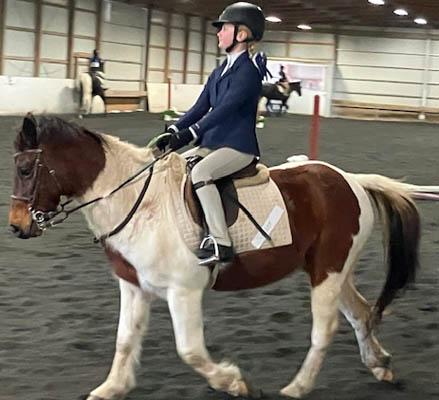
|
[Equine Equipage] A grab strap is an optional simple unattached, but buckled strap, worn around a horse's neck. It functions as a back up security aid for riders to hold. They are valued for novice riders and particularly if bouncing at the trot is a problem. Among western riders they are called a night latch.
Grade Horse
[Equine Type] A grade horse cannot to characterized by breed and is of mixed heritage.
Grand Champion
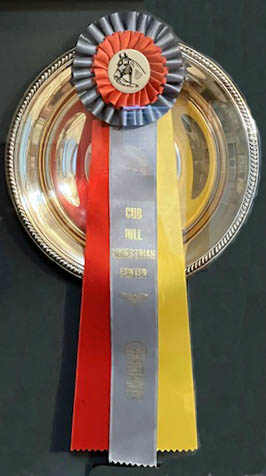
|
[Equine Competition] The grand champion is the first place winner of the championship category. A combined red, blue and yellow ribbon is awarded in the U.S. or a red, white and blue in the U.K. Various nations all have their individual color systems for show ribbons.
Grand National
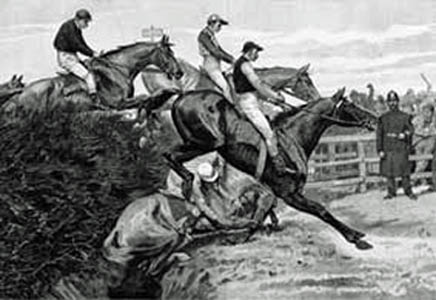
|
[Steeplechase] The Grand National is considered the most demanding steeplechase race in the world. It is held in the spring at Aintree Race Course, near Liverpool, England. The course is over 4 miles long and has 30 obstacles and the race has been run since 1839.
Grand Prix
[Show Jumping] The highest level of competition in show jumping. The term is from the French meaning: major prize. If you have ever watched a competition they have earned it.
Grass Founder
[Veterinary Medicine] Grass founder or laminitis is an inflammatory condition of the laminae of the hoof in horses and ponies, resulting from being placed on a rich spring pasture. Ponies are particularly susceptible. The affected animal may run a fever and avoids bearing direct weight on the involved limb. The hoof is warm to the touch and applied pressure pressure produces pain. An animal may recovery from a mild case but the prognosis is poor in more severe cases. Founder is best prevented. Keeping them off rich pastures and using a muzzle are useful in prevention.
Grass Sickness (Equine Grass Sickness or EGS)
[Veterinary Medicine] see Equine Grass Sickness
Gravel (Suppurative Pododermatitis)
[Veterinary Medicine] Gravel is a hoof infection that develops in the sole and travels upwards in the hoof to erupt through the coronary band. It is one of many causes of lameness. It is caused by some foreign material introducing bacteria into the hoof, not necessarily gravel. Treatment can be "expectant." That is to say observation and non-intervention, nature taking its course. There is some rational for bandaging and foot soaks. The enthusiasm for surgically opening up the abscess seems to have waxed and waned over the years I have had horses. Many vets argue for early surgical management as a means of aborting the process and immediately relieving discomfort. As a general rule, antibiotics have no role in the treatment of abscesses. However, if there is significant infection in surrounding soft tissue an argument for their use might be made.
Gray Coat Color (Grey by British usage)
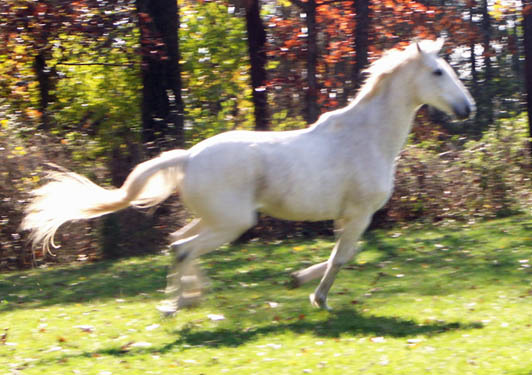
|
[Equine Coat Color] Gray Horses have progressive depigmentation of the colored hairs of the coat. Most gray horses have black skin and dark eyes. They are born a dark black or brown color and over years progress to a gray color and then the a white color. There are rare situations were horses are born white. These have pink skin and can have blue eyes. Gray color is control by the gray gene (G) is an autosomal dominant gene. A parent horse that is homozygous (GG) with two gray genes will always have gray offspring. Gray horses have an 80% life time risk for melanoma tumors. Melanoma in horses is serious but does not progress as quicky as it does in humans,
Graying with Age
[Equine Hair] Horses are one of a small group of animals, including dogs and men that exhibit the graying of some hairs with aging.
Grazing Bit
[Equine Equipage] A grazing bit is a type of leverage bit that has a low gentle port with plenty of tongue room and is also suitable for everyday riding. It is good for riders who wish to allow their horse to graze while on a trail ride. A horse should only be allowed to graze with the permission of the rider.
Green Broke Horse
[Equine Training] Green broke sounds like a contradiction in terms and may smack of wishful thinking on the part of a seller. The implication is that the horse has advanced somewhat in training but is not fully trained as yet. As always, a buyer should beware.
Green Horse
[Equine Training] A green horse is one that is inexperienced and not yet schooled to its potential. The term might also apply to inexperienced riders.
Green Ribbon

|
Groom
[Stable Hand] A groom is an individual responsible for preparing a horse for an event. They may be professionals or volunteers in that capacity.
Grooming
[Equine Care] Grooming is the act of removing any build up of dirt and dander from a horses coat, forelock, main and tail. This is done as routine care or in preparation for a show or hunt. The most important tools are a curry comb, body brush and comb. Grooming may benefit appearance, but its most important task is contributing to the heath of the equine coat.
Grooming Halter
[Equine Equipage] A grooming halter is a type of halter specially designed for convenience in grooming the head area. They either do not have a throatlatch or have one that can easily be detached and swung away from the underside of the horse head. They are not intended to function as an ordinary halter. I have never seen one in use and suspect most riders think of them as luxuries. Some riders will make one out of an old bridle's headstall.
Grooming Mitt (Grooming Glove)
[Equine Grooming] A grooming mitt or glove is a rubber mitt with a pebbled surface, used at the end of grooming to remove remaining fine dirt from the horse's coat.
Ground Ivy (Glechoma hederacea)
[Toxic Plant to Horses] Ground ivy is an herb that hugs the ground and gowns in patches. It has blue-violet flowers. It was used in herbal medicine, as a ground cover and even in an ingredient in brewing. Fortunately, its biter taste causes horses to generally ignore it. Occasionally, a hungry horse on an overgrazed pasture will eat it. The symptoms of poisoning include: dilated pupils, excessive salivation, excessive sweating, panting and excitability. The substance responsible is uncertain but the plant contains many bioactive compounds and the symptoms suggest a sympathetic nervous system activation or disinhibition. If present along a fence line is difficult to totally eradicate.
Ground Rail (Ground Pole)
[Training] Ground rails or poles are place on the groups, often in a series and used in training exercises
Ground Tying
[Horse Management] The term ground tying is a bit of a misnomer. The horse is not tied to the ground or anything. In fact, it is loose, but has been trained to stand still. So, both the rider and the horse are basically pretending it is tied. I had noticed this in cowboy movies as a kid and just figured it was part of the magic of the silver screen. However, when I became familiar with riding, I learned it is a real thing. It does take training to accomplish. Without getting into too much detail, I will mention some basics of the training technique. The horse is in an enclosed space and fitted with a rope halter and a 15-foot training lead. The trainer is facing the horse with tension on the line. When the horse steps forward the trainer says whoa and sends a sapping wave down the line, which repels the horse. The technique is very similar to what you do when lunging to keep the horse from approaching the trainer rather then going in a circle. In practice, I find this harder to do than you might think. It is all about timing and giving just the right amount of negative re-enforcement. I have never had a horse that ground tried, as much as it would have been useful on many occasions. Like too many of my fellow riders, I just want to get on my pony and ride rather than spend time doing ground work. If my horses are ill-mannered and ill-trained, I have only myself to blame.
Groundwork
[Training] Ground work are schooling exercises used to train or exercise a horse, often a green horse. They include lunging, backing up, touching (handling), leading, desensitizing, circling, etc.
Grullo (Grulla)
[Equine Coat Coloration] Grullo colored horses are duns with tan-gray body hair. In addition they have so-called primitive markings, consisting of a dorsal stripe, horizontal striping on the back of the forelegs, a transverse stripe over the withers, dark masking on the face and zebra stripes on the legs. In some light they have almost a blue cast. There is also a lot of variations of the basic color. Grullo coat colors can be found in a number of breeds including Sorraia, Gotland, Appaloosa and even some Tennessee Walking Horses.
Gullet
[Equine Saddles] The gullet of a saddle is the distance between two points on a saddle's tree (underlying support structure of a saddle). The forward gullet may receive the most attention, but there are also back gullets, bar angles and bar channels to be considered in sizing a saddle. The term gullet applies in both English and western saddles. Unfortunately, this measurement is not totally standardized between various manufacturers. The take home message is with saddles it is not a one size fits all situation. If you are in a saddle for hours, you need one that fits both you and your horse. The entire function of a saddle in a secure coupling between the anatomy of a rider's seat and a horses back. I cannot think of anything worse than riding somewhere and drawing a saddle that is too small.
Gullet Bar
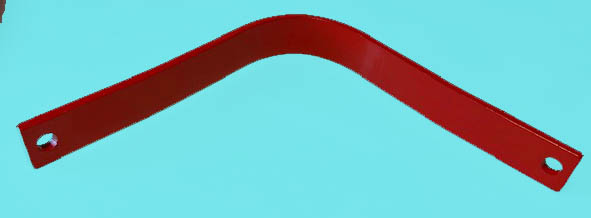
|
Gypsy Vanner
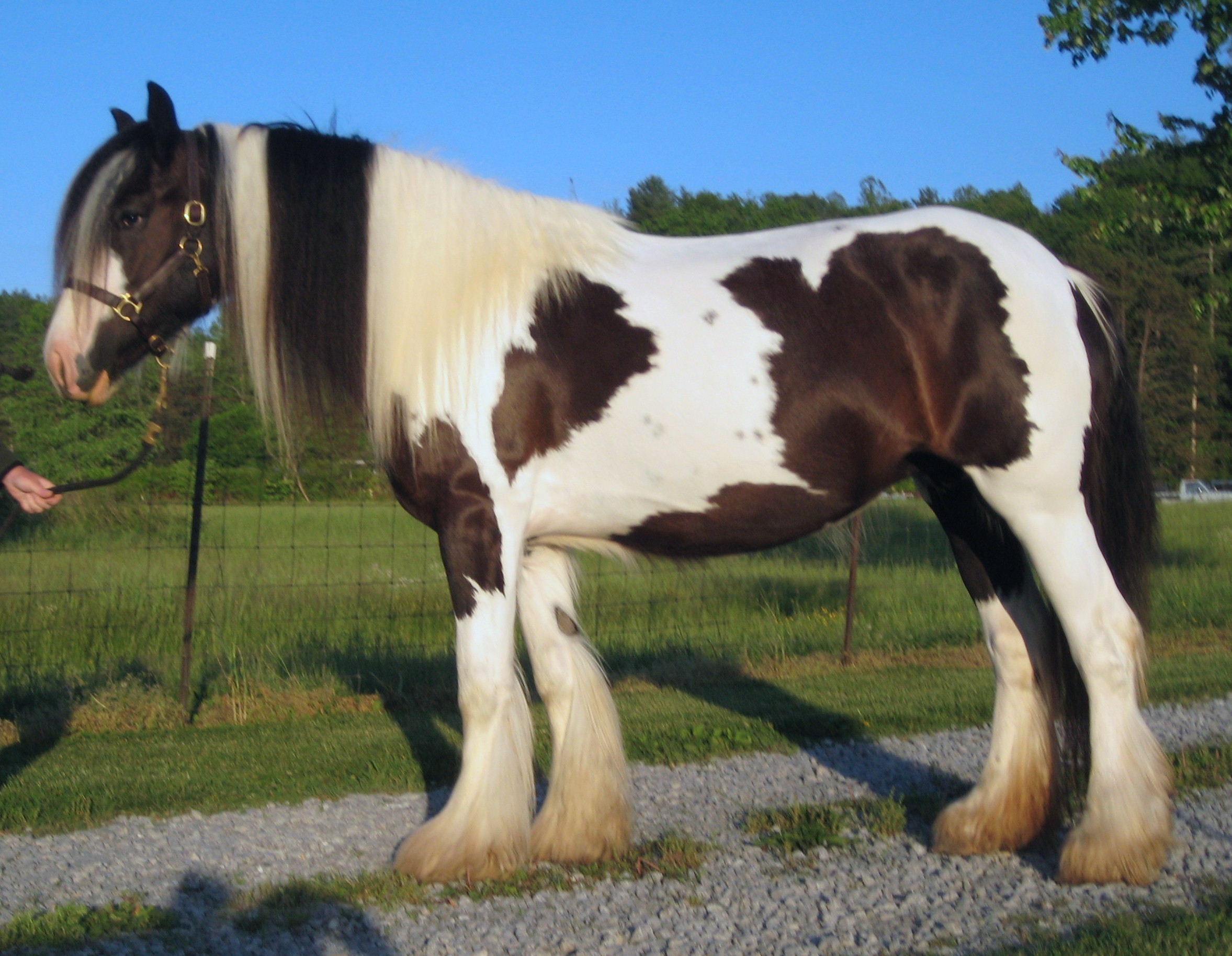
| 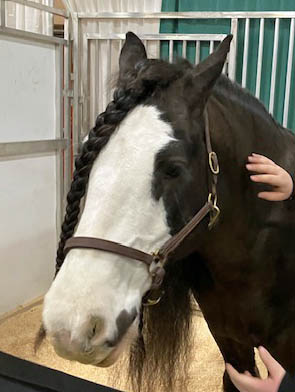
|